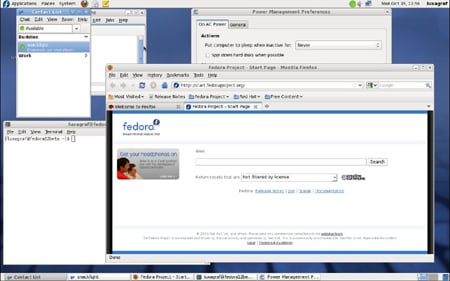Original URL: https://www.theregister.com/2009/10/20/fedora_12_beta_1_review/
Fedora 12 polishes Linux for netbooks
RHEL power management
Posted in OSes, 20th October 2009 23:52 GMT
Review The Fedora Project has released the first beta of Fedora 12, the next major revision of the Fedora Linux line, and though it's still a work in progress, there are already some standout features, including a much improved power management system and support for the Moblin project, Intel's effort to make Linux work better on netbooks and mobile devices.
Fedora has never been shy when it comes to adopting new features. Fedora 11, for example, was one of the first major distros to adopt the ext4 files system. But with Fedora 12 the focus is much more on feature refinement and improving the stability and functionality of some features introduced in Fedora 11.
Perhaps the most practical of the new features is the reportedly improved power management system. Taking some bits from Red Hat's Enterprise Linux 5, Fedora 12 will offer a new and easy way to switch between various predefined and extendible ktune-based power settings.
The underlying power management tools, namely ktune, have been pulled from RHEL 5 and merged with Fedora 11's "tuned" system daemon and, according to the project's developers, will make Fedora 12 "use less power...while not affecting user experience."

The look and feel of Fedora 12, with the first beta
For the beta release, we stuck with a virtual machine install, so we can't verify Fedora 12's power saving potential, but once the final release rolls around, we're looking forward to putting Fedora 12's ktune to the test.
Also new in the beta release of Fedora 12 is improved support for Moblin Core, to improve performance and deliver a better graphical interface for Linux on netbooks, mobile platforms and embedded devices. Moblin Core itself is built on the GNOME Mobile platform, which is the core desktop environment that sits of top of Fedora.
The benefit for netbooks and other small screen devices is the improved user interface. Naturally, Fedora GUI environments aren't optimized for the small screens of netbooks and mobile devices, but the new Moblin spin addresses those issues and makes the Fedora on a netbook experience much nicer. Also part of Moblin is support for most of the common graphics and WiFi chipsets found in today's netbooks, though as always, Broadcom WiFi chipsets remain an issue.
New GNOME
The Fedora 12 beta brings with it the latest offering from the GNOME project, which recently released version 2.28 of the popular desktop. Most of the changes in GNOME 2.28 are under the hood, however the one noticible change - icons in menus and buttons have been turned off by default in GNOME 2.28 - isn't part of the Fedora 12 beta release.
To our eye, the desktop looks much cleaner without the icons, and we're hoping Fedora dumps them for the final release, but for now at least, the icons are still there.
The latest release of GNOME also includes the new GNOME Bluetooth module, which makes connecting Bluetooth mice, keyboards, and other devices considerably easier.
GNOME 2.28 also sees Fedora migrating to the new messenger application, Empathy, which replaces the long-standing default, Pidgin. As we noted in our review of the Ubuntu 9.10 beta, Empathy lacks a few of Pidgin's features, but it's still a quite capable messenger app. The latest release adds support for sharing your desktop with Empathy contacts using the GNOME Remote Desktop Viewer, Vino.
For those using the KDE spin of Fedora, KDE 4.3 is now the default and thankfully, sees KDE 4.x finally up to par with both its predecessor, the KDE 3 line and GNOME 2.2x.
The much-loved PackageKit, a software discovery tool that lets you quickly and easily install the application you need to open a file, now includes a browser plugin. That means if you download a PDF file, but don't have a PDF viewer installed, PackageKit will notice the download in your browser and offer to install the software you need.
Another nice under-the-hood change in Fedora 12 is the move to switch RPM package to use the new LZMA compression format. All of the software packages in Fedora have been switched from Gzip to the more efficient XZ (LZMA) compression method. The payoff for users is smaller, faster downloads.
Also new in the Fedora 12 beta is the latest version of Xorg that now defaults to, for those of you with a dual monitor setup, spanning the desktop between monitors, rather than cloning between them. Quite frankly, that's the way it should have been from the beginning, but as they say, better late than never.
While Fedora 12 is still a beta release, we didn't have any real problems getting it up and running in a virtual environment. That said, there are still a few known issues to be ironed out before the release candidate arrives, and, as with any beta software, we don't recommend running Fedora 12 beta in a production environment. ®